PEACH
PIT CARVING
Compiled by R.V. Dietrich,
Professor Emeritus
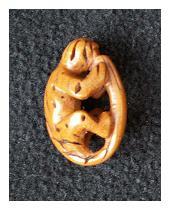
The
Appendix at the end of this file has been added since
and is NOT included in the
PDF file that is available on CONDOR (see below).
In addition,
a few updates and revisions have been made to this file -- they are in
red type.
The
material that was on this web site as of September 10, 2009,
is available as a PDF file
on Central Michigan University’s Online Digital Object
Repository (CONDOR).
HISTORICAL BACKDROP
Peach pits have
been carved for
several centuries: Tim Hallman
of the
Asian Art Museum, San Francisco, California contends that the craft
originated in China
where the Peach is a symbol of longevity(1); Wang
Xu-De, in a summary about the history of peach pit carving in China,
notes "Peach stone carving has a long history in China and is first
recorded in the middle of the Song dynasty [960 -1279]"(2); it also is recorded
that AHandiwork of
pit carving was all the rage for a time in the Ming [1368-1644]
and Qing [1644 -1911] Dynasties.@(3); [and] folklore
exhibits of the Sichuan University Museum in south-central
China include Asome fantastically small carvings
including a miniature boat and crew carved from a peach pit.@(4)
More recently:
Michigan State University lists "Peach Pit
Carving" on
its
"... topical file subjects" relating to the Michigan
Traditional Arts Program. Articles have been published
about peach pit
carving in both China and America in, for example, the periodical Chip Chats.
Carvings have been
displayed at art and craft festivals. And, a few web sites describe
and/or illustrate relatively recently
carved peach pits.
So far as the
place peach pit
carving has in the world of arts and crafts, the
following
rather apt statement seems to "say it all" – i.e.,
for all, save a few professional, peach pit
carvers whom I know or have read about: "This
unusual art form seems not to
be attached to any specific region, ethnic group, or occupation.
One simply
occasionally finds folks who like to sit down and carve tiny figures
and baskets out of
peach pits...@(5).
PITS and TOOLS
Peach pits, sometimes referred to
as peach stones or even peach
seeds, comprise the cores
of the widely eaten fruit called peach (Prunus persica) in
English (Tao zi in
Chinese(Pinyin); pêche in French; Pfirsch in German; pesca in
Italian; fersken in Norwegian;
:,DF48 in Russian;
melocotón in Spanish; persika in Swedish; fershke in Yiddish; etc.).
In
America, several peach varieties, most of which are hybrids, have been
given
names such as
Redhaven and Georgia Belle. All, however, fall into two major
groups, usually referred to in
the vernacular as Afree
stone@ and Acling.@ – I have been unable to find out whether the six rather
different varieties recorded as supplying the recognizably
different
peach pits used for carving in China(6) also fit into these two overall categories. – In any case, it
has been my experience that
the pits in today=s hybrid
peaches – i.e., the ones readily availble in
markets in the United States and Canada –
are not nearly so amenable to carving as the
pits from the peaches availble during the 1930s and 40s were.
Also, it seems to me that for the most part pits from cling
peaches are more workable than those
from free stone peaches.
Peach pits
consist
of two main parts:
an outside hard wood-like material (putamen) and
an enclosed nut-like, cyanide-containing seed (kernel). The
wood-like
material, which is
carved, typically has many irregularly shaped open spaces and a
hardness similar
to that of hard
maple, except for a softer zone where it was attached to the
stem. Unlike most wood, however, the typical peach pit has
virtually no grain except along
one of its edges (see
Figure1B).
The seed is removed from most carvings, and in any case does not become
part of the
finished products. With a few exceptions, pits I have seen have
greatest dimensions that
range from 2 cm to 4.5 cm – i.e.,
from ~ 3/4 to ~1 3/4 inches. Their
colors range from
light tan to medium brown with some
having reddish or yellowish orange hues (see
Figure 2 and the illustrated carvings).
Figure 1. Peach pit, from left to right:
A."front view" with stem attachment area at x;
B.
& C.side views, "B" the side having the complex "rib" that is
noted
in the text as having a grain,
that
grain trending supparallel to the length – i.e.,from top to bottom in
the photograph;
D.sawn
half of pit the central
part of which is half of the cavity where the seed occurred;
E.cross section cut perpendicular to "D" to show concavity; F.a
dried seed.
Figure
2. Dried
peach pits with diverse
characteristics that are typical of those I have found.
Tools used
differ
from carver to
carver: Some carvers use only
simple knives – jackknives, penknives
and/or paring knives. Others, especially professional carvers,
use
several diverse additional tools – e.g.,
files, chisels, gouges, exacta knife blades and scrapers, some of
which are miniaturized (see Figure
3 and note reference 6) – which are
virtually essential to produce the intricate details manifest by some
carvings (see Figure 4 and illustrations in reference 6a). In
addition, some carvers
also use tools, such as burs, attached to electrically
powered flexible shafts like those formerly used by most dentists,
especially for roughing out
their desired forms before they carve their end products.
Some carvers also use magnifying lenses while carving details such as
intricate floating designs. And, many carvers also use sand paper
or other
abrasives for shaping as well as for so-to-speak finishing their
carvings.
Figure 3. Tools. Left, top to
bottom, Grandpa Dietrich's jackknife, my jackknife and paring knife.
Right, Some of Janel Jacobson’s
carving tools – ( © photo
by
Janel Jacobson,
reprinted here by permission; see www.janeljacobson.com/carvings/325)
Miscellany
"Children
in
China wear a peach
pit suspended about the neck to
keep demons away."(7) Perhaps
this relates to
the fact that peaches are considered to symbolize long life –
apparently in the same
general sense as "an apple a day keeps the doctor away" – i.e.,
if
eaten regularly they are said to prolong life (8). Along this
line, it is of at least passing interest that
the
peach "was once
thought to be native to Persia (Iran) but recently, scientific
consensus is that it
originates from China" (Desmond R. Layne, personal communication, June
2005), and
"Efforts at domestication and improved culture of peaches [in China]
have been
documented over the last 2500 years."(9)
According
to the
Illinois
Humanities Council, in a brief note about Abraham Lincoln artifacts, "Dr.
Weldon Petz, of West Bloomfield, Michigan, recently donated almost
40,000 items to the
Plymouth Historical Museum [Plymouth, Michigan]. He began his
collection in the
1940s while performing with the big bands in New York, although his
fascination with the
man began when he was a boy of 8. ... [One of his
favorites is] a peach
pit in the shape of Lincoln's head and face. Carved by a man
serving time in prison,
Dr. Petz was struck by the fact that someone going through such a
difficult time had
carved the image of Lincoln. He kept the carving when he
donated most of his
collection to the museum."(10) See Figure 4.
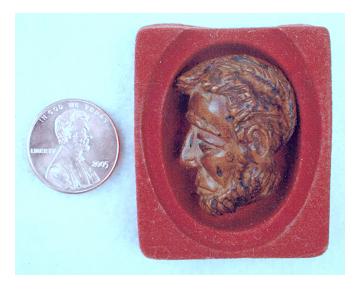
Figure 4. Dr. Weldon
Petz' peach pit carving by a prisoner of war during the
War between the States (American Civil War) of the 1860s.
( © photo
by Dr. Petz)
At least one
other President of the United States of America has been
the subject of a peach pit carving -- one with some remarkable details,
which include the following (See Figure 5.): A portrait of John F.
Kennedy, wearing a veterans hat; the inscription
"President John F. Kennedy of United States" above his head; an
eagle on a shield to the left of President Kennedy (i.e., to his right); a
depiction of St. Christopher, below the eagle and shield; foliate
patterns below and to the right of the President (i.e., to his left); and "R.J.
McErlane," the name of the carver, along the lower left side.
This carving was donated by the carver to the John F. Kennedy
Presidential Library and Museum, Columbia Point, Boston,
Massachusetts, where it now is housed.
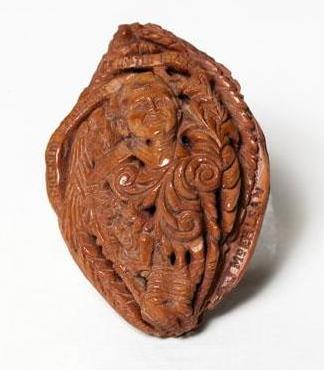
Figure 5. R.J. McErlean's peach pit
carving of President John F. Kennedy.
Description is given in preceding paragraph. The pit is
approximately 38 cm in greatest dimension.
(photograph was downloaded from www.jfklibrary.org
, which Stephen Plotkin,
Reference Archivist, informed me is in the public domain.
Moving
from the
sublime to, in my opinion, the
ridiculous – the following
appears on the internet under the title Meriting the Merit Badge:
"The merit
badge counselor looked quizzically at the Scout. ‘Wood carving, eh?’ he
observed. ‘And this is made from a peach pit? Carved it with your
pocketknife!
It's a neat piece of work.’ But then the kindly counselor went on to
point out that
the Scout had not used the tools of a wood carver, that excellent as
this peachstone
neckerchief slide was, the Scout had not actually and fully met the
requirements for the
merit badge."(11)
Some peach pit carvings have been mounted on
pedestals. See Figure 6.
 Figure 6. "Clouds & Trees," front and back views with
larger views on sides to show details better.
Figure 6. "Clouds & Trees," front and back views with
larger views on sides to show details better.
Carved by Janel Jacobson, 2000. ( © photos by
Janel Jacobson, reprinted here by permission)
Robert Shamey of
Ligonier, Pennsylvania has, like some Chinese carvers,
extended his carving of peach pits (e.g.,
Figure. 7) to several other pits and
seeds, Shamey carves pits/stones/seeds from, for example, sweet cherries,
sweet black cherries, choke cherries, olives, plums and even the seeds
from
inside the red berries
of Dogwood trees. Examples are shown on
his web site(12)
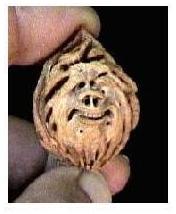
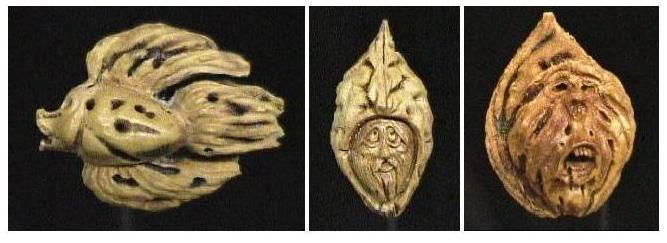
Figure
7. Unnamed peach pit carvings by Robert Shamey. Three
bottom ones are enlarged
to show details. ( © photos by Robert Shamey, www.shamey.com/pit/pit.,
reprinted here by permission)
Henry
Clay Hogeland (1913 - 1987)
formerly of Birmingham, Alabama
carved more
than a “shoebox full of monkeys ... from peach pits. He was a
railroad engineer and carved while he worked as well as during his time
at home. His only carving tool was a Tree pocket knife.” (Shelia
H. Pickett of Oneonta, Alabama,
daughter of Mr. Hogeland, personal communication,
2008) As can be seen on Figure 8, Hogeland’s monkeys had
different appearances than those widely considered traditional. -- Note
for example, the one wearing a hat, the ears on the other three, and
the brightly colored faceted glass "gemstones" for the eyes on two of
those shown. The possibly
disturbing luster that is apparent on the
photographs
is due to the fact that he coated each of his carvings with colorless
nail polish.
Figure
8. Examples of peach pit carvings by Henry Clay Hogeland.
(carvings
in collection of Shelia H. Pickett).
Several
other
peach pit carvers are known for their works. A few of them,
including
both Americans and Chinese, are mentioned in articles published
in Chip Chats. Also, a
few carvers and marketers exhibit carvings on web sites – e.g., see Figure 9, which shows
two of my favorite
groups from the stand point of their preservation of the original
characteristics of the peach pits.
Figure 9. Top.Three of the so-called "standard" basket
carvings.
Carver(s) unknown.
( © photo by Ron Toth, Jr.
http://www.timepassagesnostalgia.com/, reprinted here by permission)
Bottom. "Whimsey pin" from early1900s. Carved leaf (width ~9 cm)
with three dangling peach pit
baskets that are attached with copper loops; safety pin on back
is wearing clasp.
( © photo reproduced from www.folkartisans.com
with
permission)
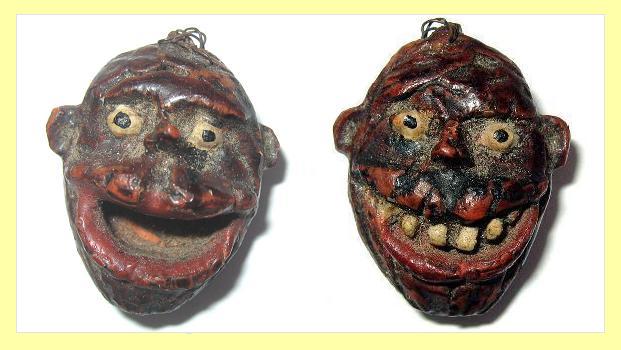
Figure 10. Enlarged views of two sides of one carved peachpit
(height ~ 2.7 cm),
parts of which have been painted.
This carved pit is from an estate sale that was held in the Washington
D.C. area.
Nothing is known by its current owner about its source etc., but she
notes that
"most people's estate sales in the DC area were from people who
traveled quite a bit!"
(© photos by Eva Kisevalter [email: stellavanilla@mac.com], the
current owner)
PERSONAL EFFORTS
George B
Dietrich (1860 -1941),
my grandfather, introduced me to peach
pit carving in the early 1930s. Grandpa used only a
pocket knife and fine sandpaper, and perhaps – I am not sure about this
– rubbed them with linseed oil to give them the finish he
preferred. One of his carvings, "A
monkey
biting his
tail" – one of the so-called old standards – is shown below the title
and also as Figure PE-0, left.
During the next sixtyfive years, my
carving of peach pits was limited to a few
baskets – the other "old standard" – nearly all of which were fashioned
quickly
just to show some disbeliever that
something could be carved from a peach pit.
My
first one,
perhaps my best because it was made under Grandpa Dietrich’s guidance,
is shown as
Figure PE-0, middle.
Figure PE-0. Left to right: Two standards – monkey biting tail by
George
B Dietrich;
basket by R.V. Dietrich (his
first carving at ~ 9 years old).
and a small heart-shaped pendant fashioned
from a
peach pit similar to those of the Pan Peach of China (6)
The last few years, just for the fun
of it, I have carved
several pits to
represent all sorts of real and fanciful animals, plants and other
shapes.
Several of my carvings
arise from what I see as inherent forms of a given pit: Some
of these forms are
apparent to me before I start carving; others "come to light" as
I carve,
frequently resulting in something quite different from what I
originally planned. In any case, as the characteristics of my primitive
genre carvings indicate, I use only pocketknives
and/or common paring
knives and
sandpaper for shaping. To give the fashioned pieces a
somewhat
lustrous (satiny) finish, I rub
them with Brazil and/or pecan nuts and brush them with a soft tooth
brush. A few examples of my carvings are shown as
Figures PE-0 - PE-8.

Figure
PE-1. Diverse baskets, left to
right: the old standard
with handle across greater width;
one with handle across the depth –
i.e.,
shorter width;
one with handle at a right
angle to the length;
one shaped like an urn, with no handle.
Each is free standing.

Figure
PE-2. Humanoids: the one on
right is "a man from the 'Planet
of
Apes' "
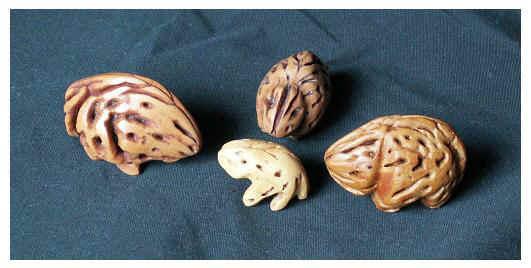
Figure PE-3. Miscellaneous
grazers – each stands
freely
on a flat surface.
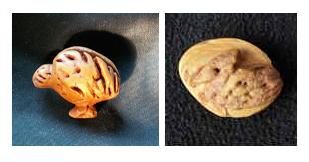
Figure PE-4. Birds:
Left, Ptarmigan; right, hooded merganser "cameo."

Figure PE-5. "Symbols" –
left to right: "Lamp of
learning,"
"Eternal
flame" and "Magi
bearing gift".
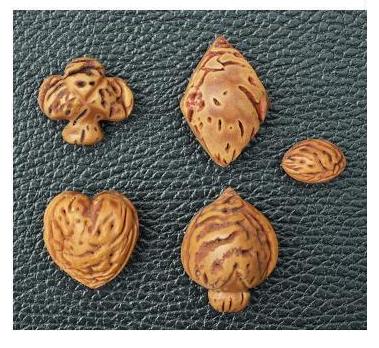
Figure PE-6. Club,
diamond, heart and spade plus,
center-right, the
smallest pit I have ever
been given to carve; after just rounding it off, a friend suggested
I leave it that way and just call it a football.
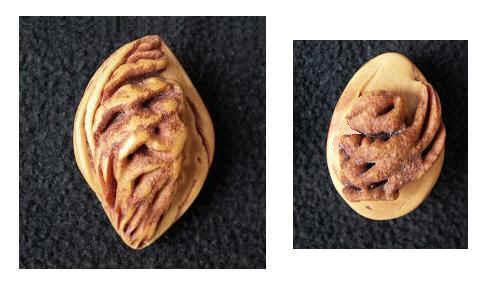
Figure PE-7.
Two
"inherent forms" as cameos:
"Old
Man Winter"
or "Jack
Frost" (your choice) and a
squirrel.
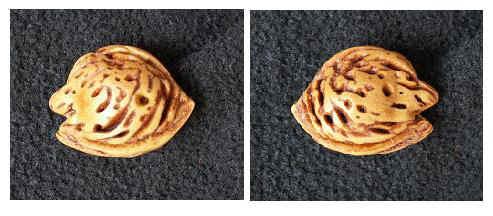
Figure
PE-8. Two for one
:
Left, fish; right, fledgling with open beak.
References:
(1) "Peach pit carver releases the art
within."
2001. < archives.cnn.com/2000/STYLE/arts/05/15/peach.pits.ap/index
> (accessed: 3-June-2005)
(2)
Xu-De,
Wang. 1994. History of peach stone carving in China. Chip Chats. Sept.-Oct.:66-67.
(3) "Jingtan
network." 2005. < www.alibaba-online.com/trade/company/goto/10007874
> (accessed: 2-June-2005)
(4) "Local
attractions: Sichuan University Museum." n.d. <
www.scu.edu.cn/home/math/local%20attraction > (accessed:
1-June-2005)
(5) "Tucson
entertainment," n.d.
< www.tucsonfestival.org/TMY/FolkArt/TucsonMeetYourselfFOLKartWHITTLINGandPEACHpitCARVING
> (accessed: 29 May 2005)
(6) Xu-De,
Wang. 1995. How to carve peach stones. Chip Chats. Nov.-Dec.:34-38.
(6a)
Xu-De, Wang. 1992. Chinese carver turns peach seeds into objet d'art
(translation of letter to editor). Chip Chats. Nov.-Dec.: 14-15.
(7) "Traditional
uses of herbs." 2002.
< www.runningdeerslonghouse.com/webdoc20 > (accessed: 30 May 2005).
(8) "Elder
artist shows how patience takes the
peach." 2005. < english.epochtimes.com/news/5-5-24/29034
> (accessed: 31-May-2005)
(9)
Layne, D.R. 2005.
Stone fruit - Desmond Layne looks at China's past and present peach
market. American Fruit Grower.
125(#3):54-55.
(10) "Illinois
humanities council" 2004. < www.prairie.org
> (accessed: 30 May-2005)
(11)
"Scoutmaster’s minute - meriting the
merit badge." n.d. < www.scoutresources.org/bs/sm_min/merit-the-badge
> (accessed: 1-June -2005)
(12) "Shamey
Metalcraft - The pit heads."
n.d. < www.shamey.com/pit/pit.htm
> (accessed: 31-May-2005)
~~~~&&&&&~~+&+~~&&&&&~~~~
ADDENDA: A Few
Things Relating to Peach Pits that
I Found Interesting
The items are given in the following general order: peach pits
not modified by carving (etc.);
carved or otherwise shaped pits by probable date of original
modification; [and] miscellany.
Gas mask filters: Girl scouts -- "During World War
I, girls learned about food production and conservation, sold war bonds
and collected peach pit for use in gas mask filters." (A0) -- And,
"activated carbon is still the best sorbent for organic vapors, and
many types of carbon are used in respiratory protection devices today,
including carbon made from peach pits." (William Plack,
personal communication, 17 May 2006).
"Peach-pit Jesus": Someplace near the Coast of the
Carolinas: "The woman told me she'd seen Jesus in a peach pit.
'It's true' she said 'and well-documented' nodding to the yellowed
newspaper clipping taped to the side of her fruit stand. ¶
There it was — a picture of her blessed neighbor — a Miss Lorraine
Mills, holding the pit in one hand and pointing to it with the other.
Apparently, Jesus revealed his image from out of the dregs of her
homemade peach wine. [And,] once the word got out, believers came from
all over to see His face in the crevices of that peach pit."(A1)
Peach pit spitting: The Johnson County
Peach Festival -- said to be "the oldest [annual]
outdoor festival in the state"-- held in Clarksville, Arkansas,
includes
fiddling, horseshoe pitching, jumping frogs and peach-pit spitting.(A2)
Peach pit
painting: "Use a peach pit
to paint a peachy picture. On a table covered with
newspaper, place shallow pans, containing orange, red, and yellow
tempera paints. Place newsprint paper into a shallow box lid, such as a
shoebox. Dip the peach pit into the color of your choice and place into
the box lid containing the newsprint. Tilt the box lid back and forth
so that the peach pit rolls around and paints on the paper. Continue
dipping the peach pit into the various colors and painting until you
are satisfied with your masterpiece!"(A3)
~~~~***~~~
Buddhist
prayer bracelets(?):
Bracelets consisting of "Hand-carved peach pits, each ... a
detailed monk['s head] Used in Buddhist prayer." are illustrated
on
the internet marketplace.(A4)
Sanded and half burned: An interesting "Peach
Stone Game" that "comes from the Six Nations of
the Iroquois...[and] originiated from our creation story ... In the
present time it's played during certain ceremonies, mid-winter, seed
ceremony and the harvest ceremony. the Peach stone game is a bowl/dice
game. The dice are the peach pits that are sanded smooth, and one
side [of]the peach pit is burned and the other side is a natural
color." The game involves shaking the pits in the bowl and
pouring them out, and the number of peach pits landing on the dark
versus natural colored sides is the basis of the scoring. For
details, see the below cited web site.(A5)
Bryan
and Darrow
Exchange Gifts:
The
following newspaper report (name of paper not given) is verbatim(A6):
DAYTON, Tenn. July 15. - William J. Bryan and
Clarence Darrow, Fundamentalist and agnostic, antagonists in the Scopes
trial, exchanged courtesies in the Rhea County courtroom today at the
end of the day's session. ¶ Mr. Bryan went to Mr.
Darrow in
front of the bench with the image of a
monkey in his hand. He was smiling. A friend of mine sent me this and
asked me to
give it to you," he said. "It's carved from a peach pit, and it's so
pretty I'd like you to keep it." ¶ "I'm glad
to have it," said Mr. Darrow, also
smiling, as he took the gift. "I have one almost like it, and I'll give
it to you in exchange."
Peach
pit-wok
"panjo": Of the
interesting people Forman met while on the road, "One of his most
surreal memories was made in Kansas while
hanging out with a guy named Dwayne, who carved pieces of art out of
peach pits. After jamming with Forman for a bit, Dwayne pulled out his
musical invention, which he called a 'panjo,' and which Forman
describes as a banjo made from a wok pan that was adorned with peach
pit art." (
From -- "A Western Thing Cow Bop’s jazzed-up Western music helps Bruce
Forman feel at home."(dated July 07, 2005) by Stuart
Thornton (A7)
~~~~***~~~
Porcelain
Peach Pit: A "nature
inspired Peach Pit Yixing teapot [that] conveys the ever-renewing
spring of life....[:] A naturalistic peach pit serves as a finial for
the teapot lid.(A8)
A
noteworth analogy: In an article
"Neutering Social Security" (dated April 5,
2005) by Jim Hightower, it is noted that
George W. Bush is "currently squawking like a rooster choking on a
peach pit" in his efforts to change Social Security. (A9)
~~~***~~~
Addenda
References:
(A0)
Events at the Yorktown Museum-Girl. 2000-2003. < www.yorktownmuseum.org
> (accessed 24 July 2005)
(A1) A
Cook's Notebook|Peach-pit Jesus. 2003. < www.cooksnotebook.com
> (accessed July 23, 2005)
(A2) Featured Events: Events: Arkansas
Travel.com. n.d. < www.arkansastravel.com
> (accessed July 22, 2005)
(A3)
Picture Frames.
2001. <
www.teachyourzoo.com
> (accessed July 22, 2005)
(A4)
Bracelet Peach Pit - Made in China... 1997 - 2005. < www.cyberimport.com
> (accessed July 23, 2005)
(A5) Arts, Crafts
and Games. n.d. < www.4directions.org
> (accessed July 22, 2005)
(A6)
The
Scopes “Monkey Trial.” [July 10-25,1925] or
“A 1925 Media Circus.” n.d. < www.borndigital.com/scopes.htm
> (accessed July 21, 2005)
(A7)
Monterey County Weekly. 2005. <
www.mcweekly.com
> (Accessed July, 22, 2005)
(A8) Peachpit Yixing Teapot.
2000-2005. < shop.store.yahoo.com > (accessed July 23, 2005)
(A9)
AlterNet: Neutering Social Security. 2005. < www.alternet.org
> (accessed July 22, 2005)
|
Home |
Appendix.
Additions to this
file since it was converted to the
PDF file that is available on CONDOR.
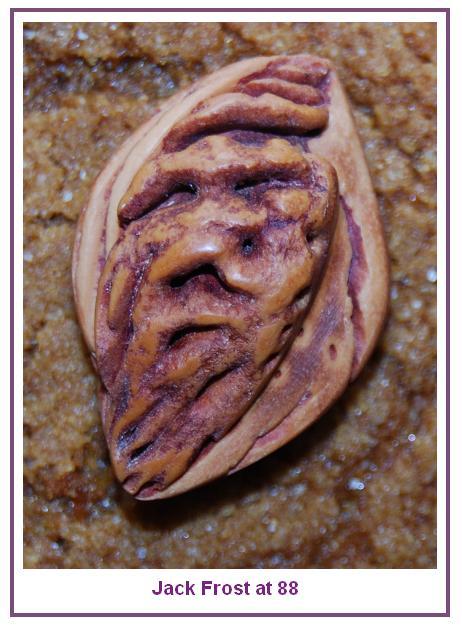
App1. This
version, a photograph of the left "carving" shown in Figure PE-7
was made on the compiler's 88th birthday. The background is a
ginger snap.
Its detail is better shown in this photograph.
~~~***~~~
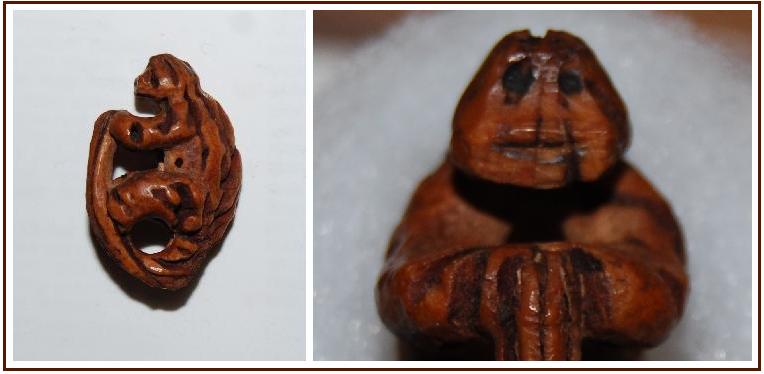
App2. This is
the only peach pit carving that resembles the old standard
"monkey biting his tail" with the end of the tail not extending into
the monkey's mouth
(left). Whatever the explanation, the carver gave the monkey a
face
(right). One wonders if it's expression says something such as
"Good
Riddance." (carving in collection of Rickey Wilson)
~~~***~~~

App3. This typical
"monkey biting his tail" carving was send to the compiler while he and
his wife were at a summer home on the St. Lawrence River, It and
the background tomato were picked up in nearby
Hammond, New York. The carving is by the widely known carver of
all sorts of pits, Robert Shamey.
~~~***~~~
App4. Recently,
I received an email that relates to a use
of carved peach pits of which I had not known:
"i remember my father
carving peach pit whistles. can you tell me how to carve
them [to make such whistles]?"
(T. Menzie, 14 July 2012).
This led me to some carving and lots of
blowing. Two of the results that I fashioned gave whistle sounds,
albeit not loud or of great quality. The following rough sketches
of cross-sections of these two -- i.e., A and B -- show their
general shapes:
A has the
basic design of many whistles -- e.g., those commonlhy associated with
police and postal delivery people; one aspect of these made from
peach pits is especially important -- the hole into which air is blown
should be only a thin slit.
B is an
example of "whistles" produced when one blows across the open end of,
for example, the
top of a bottle. The one I made produced a louder whistlelike sound
than A. Consequently, I blew across the tops of several
peach
pit basket carvings in my collection; each includes an
open-topped otherwise enclosed space -- i.e., they have the same
general
shape as B. Some of them produced whistle-like sounds, others
did not, at least so far as any within my hearing range.
.
Later, I checked some other
carvings in my collection that seemed possibly to have shapes that
might produce a whistlelike sound. One of them, the general shape
of which is shown as C of the
cross-sections, produced a good, loud
whistle. In fact, it produced a whistle sound that I consider to
be of much better quality than any of the sounds produced with A or B.
In any case, peach pits can be carved to produce
whistlelike sounds! And,
I suspect that, with modifications, much better sounding whistles than
those I made can be made. Perhaps better whistles would have
general forms that differ from the three shown in the following
diagram. If any reader knows of such a whistle made from a peach
pit, T. Menzie and I would appreciate your sending information and/or
photographs of such a carving.
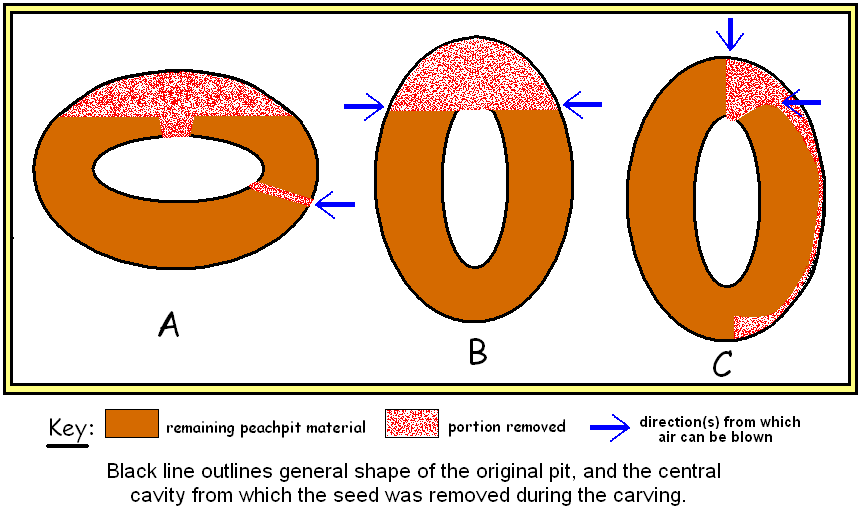
~~~***~~~
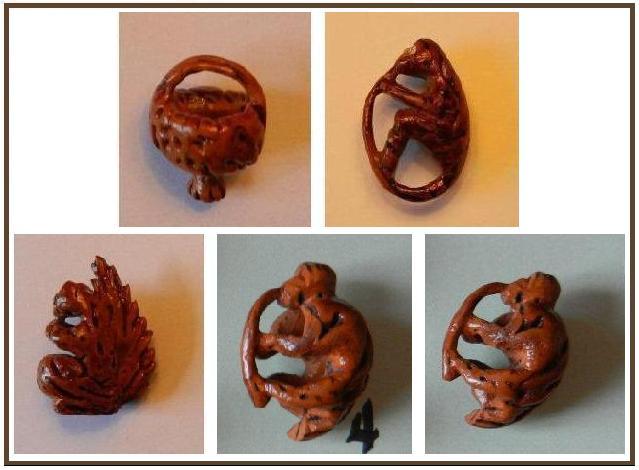
App5. These four
peach pit carvings, the origin of which is not known, were given to Dr.
Cozette Griffin-Kremer by her grandfather, "to play with when I was a
little kid" in the 1950s. The Grandfather, Francis Mitchell
Wisdom
(1878-1966), was a native of Saline County, northwestern Missouri, a
fact that may indicate the provenance of these pits.
The basket is the only one I have
ever seen with such a pedestal; when carved this basket
may have been balanced so that it would stand on a flat surface,
currently it does not do so. The squirrel has a "rhinestone"
attached to the pit as its left eye. The monkey biting its tail, upper
right, also has "rhinestone" eyes. The monkey -- bottom, center
and right --
provides particularly interesting images for me, a jack-leg
musician: It looks like this monkey is playing an
instrument, perhaps a straight -- albeit bent -- saxophone, in a jam
session.
(© photos by Dr. Cozette Griffin-Kremer)
~~~***~~~
App6. Nomenclature relating
to Peach
pits.
This addendum is included
here because of discussions I have had with some of the people who
have viewed this web site. Despite the
fact that I believe that what the part of the peach that is carved is
called by
the person who carved it or who now owns the carving is of little
consequence,
the following definitions, which I favor, are given here, for the
record. Each is a reworded
version of the definitions that appear in several dictionaries – e.g.,
“The
American Heritage Dictionary”:
Pit.
The central kernel or
stone of certain fruits –e.g., a peach, plum or
cherry.
Seed. The
propagative part –
i.e., reproduction unit -- of a plant
that can develop into another plant of the same species.
Stone. The
relatively hard cover that encloses the seed in certain fruits –
peaches, plums
and cherries. .
Clingstone (adj.). Referred
to a fruit – e.g., a peach – the pulp of which adheres to its pit or
stone.
Freestone (adj.).
Referred
to a fruit – e.g., a peach – the pulp of which does not adhere to the
pit or
stone.
~~~***~~~
| Top | Home
|
R. V. Dietrich © 2018
Revised: 9 August 2018
web
page created by Emmett Mason

